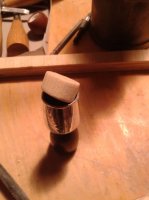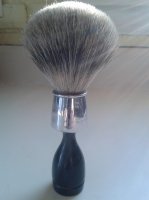Okay, after an excessively long hiatus from the forums I'm back and finally getting to work on a project brush. I need some pointers from the more experienced folk and I'm hoping my less than adequate photos will help explain my problems.
First off, I'd like to be able to identify the maker of this brand. If you can't read what it says in the photo below, it reads "Trademark Nevershed Pat. Feb. 14-05 Made in U.S.A."

Moving on. After pulling the remaining bristles out, I noticed there's a small cone in the center of the wooden handle. Would this affect the placement of the new bristles? Should I work on removing the cone and leave a flat surface? Also, you may notice that without the bristles to hold it in place, the metal ring hangs pretty loosely off of the wooden handle. Should I be trying to either epoxy or nail this in place to prevent movement?

Finally, we come to the replacement knot. Having remembered the many virtues extolled by forum members about the Golden Nib website, I immediately set about finding a replacement. I'm currently using an Omega boar bristle brush (something I picked up on clearance at Target years ago) and found a suitably priced badger hair one. Here's my main question. The new bristles measure 22mm across while the top of the opening measures only 21mm. I doubt that one measly millimeter is going to pose a problem (especially since the metal sleeve tapers outward) but I wanted to ask before doing anything foolish.
Any thoughts, comments, details, haikus or other points of interest will be greatly appreciated.
Scott
First off, I'd like to be able to identify the maker of this brand. If you can't read what it says in the photo below, it reads "Trademark Nevershed Pat. Feb. 14-05 Made in U.S.A."

Moving on. After pulling the remaining bristles out, I noticed there's a small cone in the center of the wooden handle. Would this affect the placement of the new bristles? Should I work on removing the cone and leave a flat surface? Also, you may notice that without the bristles to hold it in place, the metal ring hangs pretty loosely off of the wooden handle. Should I be trying to either epoxy or nail this in place to prevent movement?

Finally, we come to the replacement knot. Having remembered the many virtues extolled by forum members about the Golden Nib website, I immediately set about finding a replacement. I'm currently using an Omega boar bristle brush (something I picked up on clearance at Target years ago) and found a suitably priced badger hair one. Here's my main question. The new bristles measure 22mm across while the top of the opening measures only 21mm. I doubt that one measly millimeter is going to pose a problem (especially since the metal sleeve tapers outward) but I wanted to ask before doing anything foolish.
Any thoughts, comments, details, haikus or other points of interest will be greatly appreciated.
Scott



